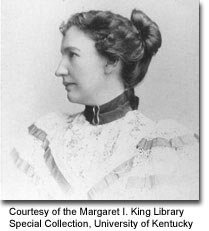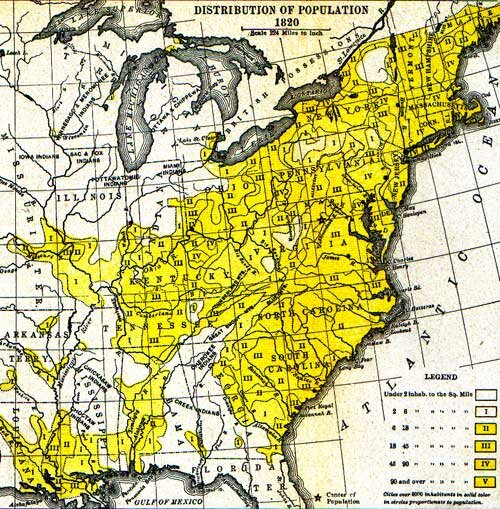|
|
Ellen Churchill Semple: The Anglo-Saxons of the Kentucky Mountains, 1901
By Nina Brown
|
|
Background
|

Semple, Ellen Churchill (1863-1932)
As a student at Vassar College, Ellen Churchill Semple majored in history, graduating with a BA at the age of 19 and later continuing on to complete a MA in history there. Her introduction to geography came after graduation during a family trip to London where she was introduced to the work of German geographer, Friedrich Ratzel. Semple read Ratzel's landmark book Anthropogeographie (1882--1891) several times, eventually resolving to seek further education in geography from Ratzel at the University of Leipzig. This was by no means an easy task since the university did not permit women to matriculate. However, Semple was permitted to attend Ratzel's lectures, sitting alone in the front of the lecture hall separate from 500 male students, and eventually studying directly with Ratzel, but receiving no degree. Although she published numerous well-received articles in European and American journals, Semple did not receive a permanent academic appointment until the middle of her career when in 1921 she became the first female faculty member hired at Clark University. She taught in the graduate program in geography there until her death. Semple received numerous honors during her career, including an honorary doctorate from the University of Kentucky (1923), the Cullum Medal from the American Geographical Society (1914), and the Helen Culver Gold Medal from the Geographic Society of Chicago (1931). She was one of the founding members of the Association of American Geographers and served as President of the Association in 1921. Despite these honors, Semple was paid significantly less than her male colleagues at Clark, a slight that eventually provoked her to retract a planned donation to Clark in a codicil to her will (Bladen and Karan 1983).
|
|
Innovation
|
When Semple began her career geography was a young field in the United States, and early researchers, heavily influenced by the earth sciences, emphasized physical geography in their work. Semple developed a new program of research into the human aspects of geography, an innovative orientation that spanned the disciplines of geography, history, and anthropology. "The Anglo-Saxons of the Kentucky Mountains" (1901) exemplified this new approach. To complete research for the article, Semple traveled to the Kentucky mountains and recorded observations about aspects of mountain life, such as housing, food, crafts, and religion. This trip was itself an innovation since fieldwork was an uncommon practice in geography at the time. From her observations, Semple documented the importance human-environment inteactions in character of places and regions. She concluded that the geographic isolation imposed by the mountainous Kentucky terrain had retarded the cultural development of the region and helped to preserve archaic patterns of life:
"In one of the most progressive and productive countries of the world, and in that section of the country which has had its civilization and wealth longest, we find a large area where the people are still living the frontier life of the backwoods, where the civilization is that of the eighteenth century, where the people speak the English of Shakespeare's time..." (Semple in McNeil 1989: 146).
This conclusion demonstrated Semple's strong belief in environmental determinism, a theoretical orientation that reflected her training with Ratzel. Her first book, American History and Its Geographic Conditions (1903), expanded Semple's inquiry into the historical development of American society. In this sweeping book Semple described the ways that the natural environment of the United States had conditioned the course of American history from the 17th through 19th centuries. The book reviewed numerous developments in American history, including the settlement of the Atlantic seaboard colonies, westward migration, the development of cities, and the expansion of road and rail systems. Semple argued that each of these developments was structured by the natural features of the land. Westward migration in the 19th century, for instance, followed the course of rivers and older 17th century trade routes while avoiding dense forest, mountainous terrain, and Native American settlements [see illustration].
These two publications, together with Semple's subsequent books, Influences of Geographic Environment (1911) and The Geography of the Mediterranean Region (1931), stimulated a great deal of debate about the connection between geography and history, leading to the formation of several interdisciplinary conferences and study groups (Bladen and Karan 1983). In subsequent years, however, Semple's research was subject to a great deal of critique and ceased to be influential within both geography and history. This was a result of Semple's strong environmental determinism, a viewpoint that later scholars rejected as overly simplistic. However, in recent years Semple has been recognized as a pioneer in the study of human-environment interaction. Because Semple was among the first to detail the ways that the natural environment impacted the course of human history, some suggest that Semple was the first location theorist (Bladen and Karan 1983). Her research also foreshadowed contemporary concerns with cultural and political ecology in the social sciences. In addition, Semple is remembered as an accomplished teacher whose students, including Preston E. James, Edwin J. Foscue, and William Van Royen, went on to have prestigious careers. Semple also encouraged several women to pursue careers in geography, including Millicent Todd Bingham, Sonia Baber, and Mabel Crompton (Bladen and Karan 1983).
|
|

|
|
This map is from Semple's American History and Its Geographic Conditions (1903). The map shows the influence on westward population movements of rivers, lakes, national roads, swamps, Native American land and fertile soil areas.
|
|
Cities over 8000 inhabitants in solid color in circles proportionate to population.
From AMERICAN HISTORY AND ITS GEOGRAPHIC CONDITIONS by Ellen Churchill Semple and Clarence Jobes (Boston: Houghton Mifflin, 1903). Reprinted by permission of Houghton Mifflin Company. All rights reserved.
|
|
|
|
|
Publications
|
"The Anglo-Saxons of the Kentucky Mountains" [1901]. Reprinted in Appalachian Images in Folk and Popular Culture. Pp. 145-174. W.K. McNeil, ed. (Ann Arbor: University of Michigan Press, 1989).
American History and Its Geographic Conditions. (Boston: Houghton Mifflin Company. Revised edition with Clarence Jones published in 1933).
Influences of Geographic Environment. (New York: Henry Holt and Company, 1911).
The Geography of the Mediterranean Region. (New York: Henry Holt and Company, 1931)
|
|
Related Works
|
Bladen, Wilford A. and Pradyumna P. Karan, eds. The Evolution of Geographic Thought in America: A Kentucky Root. (Dubuque, IA: Kendall/Hunt Publishing Company, 1983)
Colby, Charles C. "Obituary: Ellen Churchill Semple." Annals of the Association of American Geographers 23 (1933): 229-240.
Wright, John K. "Miss Semple's Influences of the Geographic Environment: Notes Toward a Bibliobiography." Geographical Review 52 (1962):346-361.
|
|
Links
|
http://geography.about.com/library/weekly/aa022301a.htm?once=true&
http://www.cybergeo.presse.fr/ehgo/sirensla.htm
http://www.unc.edu/depts/geog/swig/resources.html
|
| |
|
|
|
|
Copyright © 2001 by Regents of University of California, Santa Barbara
Web Master: , Page Author: Nina Brown
This page updated February 11, 2002
This website is designed for 800x600 resolution and IE 4+, NS4, NS6+, Mozilla 9.x, Opera 5, or Mac IE5/NS
|
|
|
|